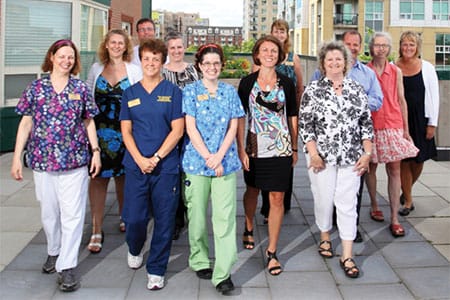Jessie Warren has started playing games at work. No, she’s not slacking off. Warren’s break-time bowling on a Wii gaming system is part of an initiative on the part of her employer to encourage the staff to become more physically active.
Warren, who works as a housekeeper and dining room server at The Berkeley at Gladstone Ridge, a retirement residence in Halifax, has recently taken part in weight loss challenges, walking competitions and Wii competitions—all at work. She says the activities are not only improving morale, but are making her and her co-workers healthier and more productive.
The Berkeley is one of nearly 50 organizations that have signed on to a program called “Stepping Up,” a physical activity strategy for the Halifax region. The program has set the lofty goal of changing the culture—by changing policies within companies and organizations—around physical activity.
The seven organizations leading the Stepping Up initiative are Capital Health, the IWK Health Centre, the Halifax Regional Municipality, the Halifax Regional School Board, the Heart and Stroke Foundation of Nova Scotia, Dalhousie University and the Nova Scotia Department of Health and Wellness. These organizations are collaborating to achieve four main goals: to increase awareness about the importance of physical activity; to provide opportunities for people to increase their activity levels; to provide supportive infrastructure and to encourage community leadership in living an active lifestyle.
Monumental task
The goals may sound simple, but the task is monumental. A full 50 per cent of Halifax residents do not get enough physical activity daily. Dr. Sara Kirk, a Canada Research Chair in health services research with Dalhousie University, says modern culture has shifted to a point where inactivity and unhealthy food choices have become the norm. According to Kirk, it is not enough to educate individuals about healthy choices; a cultural change has to take place. That change, she says, has to begin with leadership from the organizations that influence society.
The evidence supporting the need for such a shift is substantial. Kirk and her team studied 5,000 Grade 5 students in Nova Scotia and found that obese children cost the health care system 21 per cent more than children who maintain a normal weight.
Those additional costs are not attributable just to factors like diabetes or joint problems; they are coming from higher rates of asthma, middle ear infections and depression than for normal-weight children. Kirk points out that these ailments are common to many children, but obese children are more likely to get them. She adds that the additional costs represent three per cent of the total health care budget, and notes that the underlying health issues will only worsen, and the costs grow, as these kids age.
Stepping up to change
Carol Davis-Jamieson is the regional representative with the Physical Activity, Sport and Recreation branch of the Nova Scotia Department of Health and Wellness, and the co-chair of Stepping Up.
“We’re working with organizations, because we think that the ability to change a culture around physical activity rests with the organizations that influence policy,” she says.
The strategy does not tell people how to live their lives, but encourages opportunities for physical activity. And, for many of the approximately 50 organizations that have committed to the program, that change of culture is now underway.
Steve Clouthier was just starting to consider ways to improve the physical well-being of his employees at Heritage Gas, based in Dartmouth, when he heard about Stepping Up.

The director of health, safety, environment and operations has not only adopted the Stepping Up principles, he’s expanded his health promotion efforts to include diet and nutrition. Employees at Heritage Gas now take part in Wii game challenges, do yoga at lunch hour and compete in outside wellness events together.
“Just recently, one of our partners set up a team challenge to do various activities,” he says. “Our organization entered four teams, and our teams finished in the top five—one of them was the winner. There was a lot of fun banter around the office about how many steps people were walking and how many kilometres they were running or biking.”
Clouthier’s company has also had a number of employees opt into a program that subsidizes gym memberships. Even employees at other locations, who don’t have access to the head office’s programs, are taking part. One Amherst employee has lost 50 pounds and says he’s feeling good about his new lifestyle.
Clouthier admits it wasn’t an easy change. When the company first signed up for Stepping Up in 2009, there was resistance from employees.
“I asked people to take a leap of faith,” he says. “It’s not in everybody’s comfort zone to get involved in yoga at the workplace, but it’s teaching the leaders within the organization that they have to make it comfortable for people.”
The business case for this kind of activity is substantial enough for leaders to sit up and take notice. Clouthier says he’s seen results in terms of energy and morale in his workers. Stepping Up organizers argue that, for every dollar spent on supporting and improving employee health, employers see a $4 to $8 return on investment in increased productivity and reduced absenteeism.
Powerful motivator
Engagement and improved energy levels are certainly the kinds of results Catherine Campbell has seen at The Berkeley. Campbell, who is the director of communications, says it initially took some trial and error to find programs that fit with the company, because employees work out of four different residences, on both day and night shifts.
Campbell settled on pedometer challenges as a potential motivator for her workforce. Employees track their steps; a couple of times a year, the steps are added up and the building that is home to those who have walked the greatest distance wins.
There are other prizes for individual achievements as well. “The challenge is not just about competing with people in other buildings or against one another,” says Campbell. “It is about using the pedometer as motivation to get more exercise in the run of a day.”
She says the program has already facilitated some very positive discussions about the different physical activity levels required by different jobs—and the perceived unfairness of having office workers compete against personal care workers or dining room servers who are on their feet all day.
Campbell’s response has been to encourage those more sedentary employees to think about creative ways to overcome those limitations. “This is your life. If you are sitting down at work all day, then you have to figure out a way [to get more activity in]. You don’t just cash in your chips and say, ‘I can’t exercise because I sit all day.’”
She says people are now walking and doing things like skating or stair climbing over their lunch hours. “It really does motivate people to actually measure just how much they are moving. It has been a very effective program.”
The effect has also trickled down to some of The Berkeley’s residents, who are now using pedometers in their exercise classes.
Small changes, big results
Taken on their own, these changes may seem small, but Catherine Campbell says they add up to big results. Co-chair Anne Cogdon, who is the executive director of Primary Health at the IWK Health Centre, agrees, saying she’s seen change on the roads and walkways around the city. “Over the last number of years, I’ve certainly noticed more people biking, more people walking, more people enjoying the parks.”
For her part, Jessie Warren says she just feels good at the end of the day. The activities at The Berkeley have made her feel better about herself and her workplace.
She says she now knows that her employer cares about her well-being, and she feels proud when she takes off her pedometer and sees how far she’s walked in a day—which, after a 12-hour shift, is typically about 35,000 steps.
“It’s amazing,” she says. “It makes you feel good to know that you did all that.”
